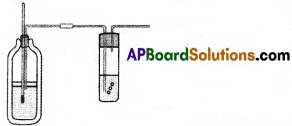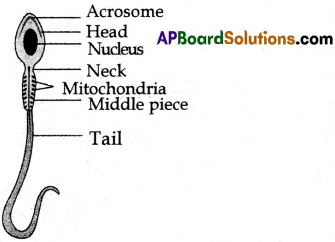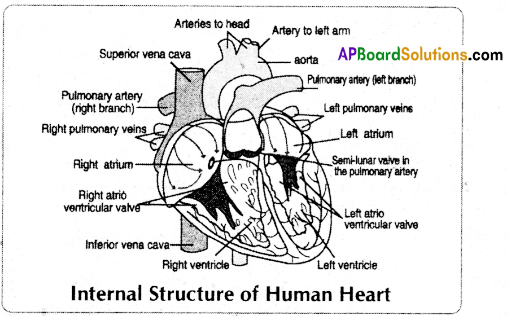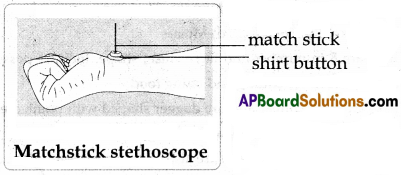Teachers often recommend practicing with AP 10th Class Biology Model Papers Set 4 to enhance exam readiness.
AP SSC Biology Model Paper Set 4 with Solutions
Time : 2.00 hours
Max.Marks : 50
Instructions :
- Question paper consists of 4 sections and 17 questions.
- Internal choice is available only for Q.no. 12 in section III and for all the questions in section IV.
- In the duration of 2 hours, 15 minutes of time is allotted to read the question paper.
- All answers shall be written in the answer booklet only.
- Answers shall be written neatly and legibly.
SECTION – I
(6 × 1 = 6 M)
Note :
- Answer all the questions.
- Each question carries 1 mark.
Question 1.
Give an example of a parasite plant.
Answer:
Cuscuta
Question 2.
Insects : trachea : : Fish : ________
Answer:
Gills
Question 3.
I am an Italian doctor. I studied about the veins in the leg and noticed small valves in them. Who am I ?
Answer:
Girolamo Fabrici
Question 4.
Which of the following statements is correct ?
A) A food chain always starts with producers.
B) A food chain always ends with producers.
Answer:
A) A food chain always starts with producers.
Question 5.
Fill the gap with an appropriate word.

Answer:
Convergent Evolution
Question 6.
The Chipko Movement is associated with
a) Fishes
b) Reptiles
c) Birds
d) Trees
Answer:
d) Trees
![]()
SECTION – II
(4 × 2 = 8 M)
Note :
- Answer all the questions.
- Each question carries 2 marks.
Question 7.
Write any two differences between afferent and efferent nerves.
Answer:
| Afferent nerves | Efferent nerves |
| 1. Carry messages towards the central nervous system from sense organs. | 1. These carry messages from the central nervous system to the body parts of effector organs. |
| 2. These are also called ‘sensory’ nerves. | 2. These are also called ‘motor’ nerves. |
| 3. These are incoming nerves. | 3. These are outgoing nerves. |
Question 8.
If you visit a doctor, what questions do you ask about pancreas?
Answer:
- How does pancreas function as mixed gland ?
- What are the main functions of pancreas ?
- Does pancreas act as exocrine gland ?
- What are the parts of pancreas ?
- Which hormones or enzymes does pancreas secrete ?
- What is the relation between diabetes and pancreas ?
Question 9.
Ramu met with an accident. His blood did not clot even after 10 minutes. What is the name of this genetic disorder? Why it happens ?
Answer:
Haemophilia. It is a genetic disorder transmitted through generations.
Question 10.
What precautions do you follow to perform this experiment?

Answer:
We should take the following precautions while doing the experiment.
- We should remove dissolved oxygen from glucose solution.
- We should pour liquid paraffin over the yeast and glucose solution carefully.
- We should check, whether the oxygen has been removed from the mixture or not with the help of diazine green.
![]()
Section – III
(5 × 4 = 20 M)
Note :
- Answer all the questions.
- Each question carries 4 marks.
Question 11.
What is a trophic level ? What does it represent in an ecological pyramid?
Answer:
Definition:
The level in a food chain at which group of organisms occur is called trophic level.
- In an ecological pyramid the first trophic level forms the base and the successive trophic levels or tiers reach upto the apex.
- In the ecological pyramid the producers are represented at the base and other successive trophic levels are represented by consumers one above the other with top carnivores at the top.
Question 12.
A) Draw a neat labelled diagram of sperm cell.
Answer:
Human sperm:

(OR)
B) What is called pumping station in human body ? Draw a neat labelled diagram of it.
Answer:
The pumping station in the human body is called heart.

Question 13.
Complete the following table.

Answer:
| Name of the endocrine gland | Location | Hormone Secreted |
| 1. Thyroid | Neck | Thyroxine |
| 2. Adrenal | Attached to Kidneys | Adrenaline |
![]()
Question 14.
Write 2 slogans about Organ Donation to create awareness among people.
Answer:
- Have an everlasting life even after death.
- Your organs to others – is like a gift to God.
- Donate your organ – and reborn.
- Have a life in others – for having a new life.
Question 15.
Explain the importance of haemoglobin in the transport of gases in respiration.
Answer:
- Haemoglobin, a red coloured pigment present in the blood is useful for the transport of substances in the body of the mammals. (Haem means iron, globulin means protein)
- Iron present in the haemoglobin binds with the oxygen and sends it to the tissues in the form of oxy-haemoglobin.
Hb + O2 → HbO2 - In tissues, oxy-haemoglobin diassociates into oxygen and haemoglobin.
HbO2 → Hb + O2 - Some amount of CO2 released by tissues combines with haemoglobin to form carboxy haemoglobin and is sent to lungs for expiration.
CO2 + Hb → HbCO2
![]()
SECTION – IV
(2 × 8 = 16 M)
Note :
- Answer all the questions.
- Each question carries 8 marks.
- Each question has internal choice.
Question 16.
A) What is Mastication ? Name the different types of teeth in human beings and write their functions.
Answer:
Mastication :
Food cannot be swallowed directly. So it must be ground, chewed and shred. This process of grinding, chewing and shredding is called “Mastication”.
- Human beings have 32 teeth. They perform different functions.
- Four different types of teeth are present in humans. They are:
- Incisors
- Canines
- Premolars
- Molars
a) Incisors :
These are 8 in number and have chisel shape. Incisors possess sharp cutting edges and are specialised for cuffing and biting food.
b) Canines :
These are 4 in number and are dagger shaped with pointed edges. Canines are designed for piercing, killing the prey and tearing flesh.
c) Premolars :
These are 8 in number and are also called cheek teeth. Premolars are designed for crushing and grinding food.
d) Molars :
These are 12 in number and are also called cheek teeth. Molars are designed for crushing and grinding food.
(OR)
B) Describe the structure of nerve cell.
Answer:
Neuron is a highly specialised cell. Neurons carry impulses or messages.

A neuron has three parts. They are
- Cell body (or) cyton
- Axon and
- Dendrites
1. Cyton:
It is the cell body. It haš a large and round nucleus. Nissi’s granules are present in the cytoplasm of the cyton.
2. Axon :
It is long and cylindrical. It arises from the cyton. The axon is surrounded by a layer of fatty material known as myelin sheath.
3. Dendrites :
Dendrites are branched thread like structures arising from cyton.
![]()
Question 17.
A) What procedure did you follow in your laboratory to observe the growth of sporangia in Rhizopus (or) common mold ?
Answer:
- Place a drop of water on the centre of the slide.
- Using a toothpick, scrape very little of the mold and place it on the drop of water.
- Then cover it with cover slip without trapping any air bubbles.
- Remove excess water at the edges of the coverslip with a tissue paper.
- Observe the slide under a compound microscope.
(OR)
B) How did you prepare a match-stick stethoscope in your school?
Answer:
Aim : To prepare a match stick stethoscope.
Required material : Match stick, shirt button.
Procedure : One unused shirt button is taken one match stick is inserted into the hole of the button matchstick is very straight in its position.
Now the button is kept on the wrist. The movement of match stick is observed. The pulse of the body is counted for one minute.

Observation:
It is observed that the match stick is moving rhythmically up and down.